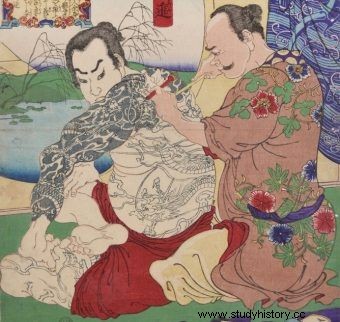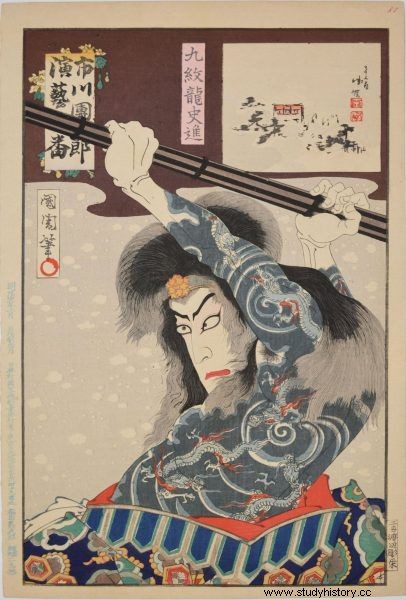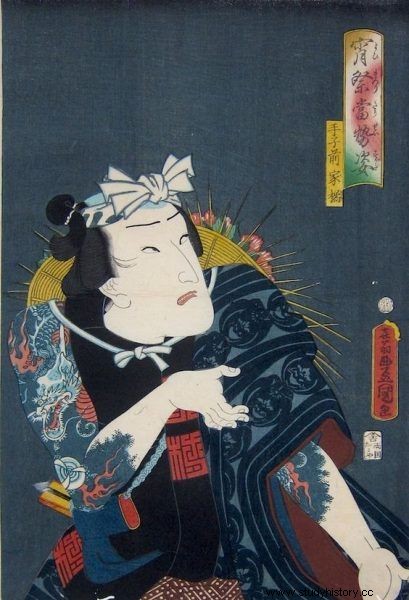The art of tattooing has a long history in Japan; Throughout history, a tattoo has been an ornament, a tool of punishment, an element of a ritual, and a symbol of belonging to strongly integrated social groups. However, it has never been and will never be the exclusive domain of the yakuza, even though many Japanese and Westerners perceive traditional Japanese tattoos and yakuza are inextricably linked.
In the Chinese chronicle of Sanguo Zhi (The Story of the Three Kingdoms), compiled before AD 300, we read that some inhabitants of the kingdom of Wa (Japan) tattooed their bodies to emphasize their social status. From the clues we find in one of the oldest Japanese written texts, Kojiki's work from around 700, it appears that in Japan, tattoos had a ritual or magical meaning. Kojiki also contains the oldest known description of striptease in the Land of the Rising Sun. However, there is no mention in the text as to whether the goddess who performed it was tattooed or not.
Social position symbol
Although not all historians have the same opinion on this issue, there are many indications that in Japan for many centuries tattoos served as symbols of social position, as well as criminal picture records, which provided more accurate and up-to-date information than Google, and additionally accompanied to those guilty of breaking the law until the end of their days. The tattoo was also undoubtedly a sign of hereditary status.

The art of tattooing in Japan has a long history
There was no slavery in Japan or a complicated caste system like India, but there was a class system. Membership in a particular class was determined by the occupation performed and the degree of kinship with the imperial family. The lowest class, the hinin - literally "non-human" - were those who performed the dirtiest and unpleasant jobs or dealt with criminals, such as prison guards, executioners, and gravediggers.
With the flourishing of Buddhism in Japan, a new class of social outcast emerged, which came to be referred to as burakumin ("village people") . They were engaged in activities considered sinful by Buddhists, such as slaughtering animals and producing leather goods. They also performed dirty and dangerous jobs that the representatives of the upper classes did not like. They were called "village people" because they lived in closed communities, separate from the rest of the Japanese. In some remote parts of Japan, isolated from the world, they live like that to this day. Representatives of these two lowest classes were often marked with crosses or lines tattooed on their forearms to keep an eye on them and keep them away from the rest of society.
Criminal Chronicle
In Nihon-shoki, another of the oldest Japanese historiographic works (with elements of mythology), there is a mention of a certain Azumi No Muraji, who was punished for treason by having his face tattooed. Ichiro Morita writes in his book Irezumi:Japanese Tattooing that in AD 460 one form of punishment was geimen, tattooing the eye area . Later it was replaced with more severe stigmatization of criminals. These new "corporal punishments" included cutting off fingers, ears and noses.
The tattooing of the eye area was returned to in 1672, and in 1720 "corporal punishment" was replaced by tattoos placed in various places on the body in a noble humanitarian gesture. The punishment in the form of a tattoo was considered exceptionally mild . This system had its advantages and disadvantages. People around the tattooed man knew immediately that he had a criminal past. On the other hand, the tattoo made it difficult for such individuals to return to the bosom of society.

For a long time, the Japanese tattoo served as a stigma and punishment
After 1720, villains were marked with symbols of the crimes they committed and the region they came from. In the Tama region, for example, the criminal's forehead was tattooed with a kanji representing a dog. In another region, it could have been two parallel lines on the shoulder or something else. Entrepreneurial, stigmatized men, however, found a way to cheat the system.
According to Morita:
[Marked with tattoos] men began to hide their stigma among fancy, artistic tattoos. Perhaps this is what prompted the first yakuza to get tattoos. Eventually, some of them started using their tattoos to intimidate victims of extortion and other crimes. They made the stigma with which they were punished as an asset and used it for profit.
In other words tattoos, instead of fulfilling the function intended for them by the authorities, became the counterparts of the yakuza daimons - something that scared the hearts of villagers and townspeople forcing them to donate money. On September 25, 1870, the Meiji government abolished tattooing as a form of punishment for criminal offenses.
Tattooed street knights
Meanwhile, although the authorities used tattoos to help people assign people to classes, punish criminals and keep "live" criminal records, during the Edo era they enjoyed growing popularity among Japanese commoners. After 1750, perhaps influenced by the extremely widely read Chinese novel, translated into Japanese, Suikoden (水滸傳), which described the tragic and heroic fate of 108 noble outlaws, tattoos became fashionable among the Japanese lower classes.
The highly sought-after novel about fearless fighters for justice has been translated and reissued many times. Many of its heroes were something like the tattooed Robin Hoods fighting against corrupt government officials. The numerous illustrations accompanying the descriptions of their adventures showed their bodies in all their glory covered with dragon tattoos.
Suikoden's heroes inspired the nascent Japanese middle class known as the chonin (townspeople). Out of the chonin, a small group of self-proclaimed law enforcement officers known as otokodate (street samurai) and a new professional group - firefighters have emerged. Their Japanese name is hikeshi, literally "put out the fire".

Tattoo became popular with the lower social strata
Both firefighters and street fighters embodied a modified ideal of a knight, guided by a code of honor, defending the interests of not the feudal lord but the commoners. If we wanted to characterize Edo Japan in terms of Star Wars - which we do whatever the Reader likes - the samurai would be the Empire's fearless stormtroopers, eagerly going to battle at the behest of their Commander Lord Vader and dying without complaint; the street fighters and firefighters would be rebels, Yoda fighters.
The samurai were instruments of oppression; they wore armor and their bodies were not covered with tattoos. Street knights and firefighters were tattooed and recalcitrant, but swore to defend the weak and fight injustice. No wonder they became the favorite heroes of popular culture.
At that time, firefighters did not have the skills we used to associate with this profession. The only method of extinguishing fires they knew was to demolish neighboring buildings to create a break in the buildings that prevented the fire from spreading. Their heroic and spectacular feats aroused admiration, and they themselves exposed their status and their bonds of professional solidarity through colorful tattoos.
Firemen were divided into kumi (groups), similar to the modern yakuza, and members of each of them often had similar tattoos. However, the first Japanese firefighters performed their duties so ruthlessly and aggressively that contemporary chroniclers often wondered who was doing the more damage:the fire or the people who put it out.
These robust and tough firefighters - who liked tattoos with water-related symbolism such as carp - with their fearlessness and a penchant for danger are sometimes considered the predecessors of the modern yakuza (or at least many yakuza would like to consider them so). Soon, not only firefighters and street knights, but also gamblers, construction workers and artisans began to decorate their bodies with sophisticated tattoos, probably wanting to imitate the fictional heroes they read about. Tattoo artists decorating the bodies of their new clients were often inspired by the woodcuts of Suikoden.
They also adapted some of the techniques used by the makers of Japanese woodcuts, ukiyo-e, among others. Often they even used the same tools, although, as you know, the human body is much softer and more flexible than wood.
Fighting with tattooing
The government, which naturally realized that fun and rebellion were insanely dangerous, banned tattooing in 1812. However, this practice continued to flourish, especially among representatives of social depressions. Tattoos as a manifestation of individualism and freedom caused anxiety in power. She was also irritated by the subversive key of Suidoken. The tattoos were a black blot on the face of Japanese morality.
The proof of the unflagging popularity of tattoos, despite the aforementioned ban, is another ban issued in the Tenpō era (1830–1844), this time concerning public tattoo competitions. During the Meiji era (September 1868 - July 1912), Japan experienced a period of dynamic modernization, and yet the citizens of this country were still unable to officially decorate their bodies with tattoos. The unusual artistic value of the traditional Japanese tattoo was appreciated by guests from the West. Not only foreign sailors made them, but even the Duke of York, later King George V, and his older brother. The full silhouette of the dragon on the Duke of York's forearm was the work of the famous tattoo master Horicho, who hailed from Kobe, the birthplace of Yamaguchi-gumi. Future tsars, members of royal families (including the Queen of Greece Olga) and many, many others willingly paid for the services of Japanese tattoo masters to bring some color and oriental mystery to their lives.
In the tense period leading up to the outbreak of World War II, tattoos were not well-received - considered too frivolous and an expression of rebellion. The practice of body adornment survived among yakuza members, some artisans, and laborers, but the triumphant return of the tattoo took place only after the war, when the yakuza flourished like never before, taking advantage of the country's chaos.
The article is an excerpt from the book The Yakuza Man. Secrets of the Japanese underworld Publishing House of the Jagiellonian University
